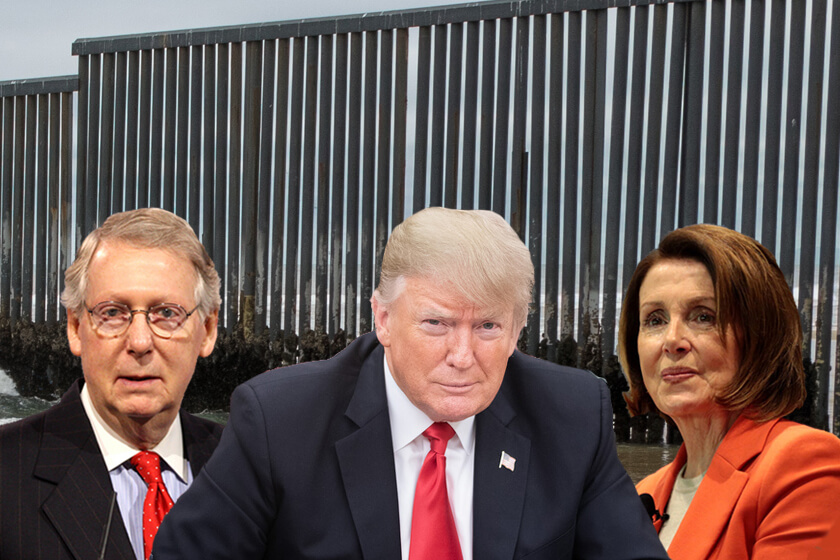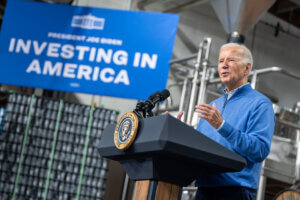West Long Branch, NJ – After ending the longest government shutdown in U.S. history, the public is divided on whether it has made President Donald Trump look stronger or weaker. Trump’s job rating has ticked down a little, but public opinion of House Speaker Nancy Pelosi has generally improved in the aftermath according to the latest national Monmouth University Poll. The public is split on whether a new budget deal should include funding for a wall across the U.S. border with Mexico, but they oppose – by a nearly 2-to-1 margin – Trump using an emergency declaration to get it built. The poll also finds that the percentage of Americans who feel that the state of the union is strong has dropped from a majority one year ago to a minority today.
Most Americans (81%) approve of Trump’s decision to reopen government for three weeks, but they are divided on how this action affects his image. Somewhat more say it makes him look weaker (32%) rather than stronger (24%), but a plurality of 41% say it has had no effect on his image. Republicans are more likely to say his action makes him look stronger (44%) rather than weaker (19%) while Democrats hold the opposite view (47% looks weaker to 10% looks stronger). Independents are split at 28% weaker and 25% stronger. All the interviews for this poll were conducted after the deal to reopen government was announced.
Trump’s overall job rating stands at 41% approve and 54% disapprove. His approval number is similar to the 43% positive rating he received in Monmouth’s November 2018 poll, while his disapproval number has ticked up from 49%. Trump’s job rating among different partisan groups in November was 83%-10% among Republicans, 42%-45% among independents, and 12%-83% among Democrats. It has not changed much among Republicans in the current poll (now 84%-13%), but his negatives have increased slightly among independents (41%-53%) and Democrats (8%-91%).
“Despite what was objectively a climbdown in Trump’s position, these poll results provide more evidence that public opinion of the president has been largely baked in since day one. The needle may move, but it does not move all that much,” said Patrick Murray, director of the independent Monmouth University Polling Institute.
Half the public (50%) says that Trump is primarily responsible for the shutdown going on so long, compared to 35% who put most of the blame on Congressional Democrats and 5% who chiefly blame Congressional Republicans. One-third (34%) say that pressure exerted by Congressional Democrats had a major impact on Trump’s decision to reopen government, another 37% say this pressure had a minor impact, and just 26% say it had no impact.
Public opinion of the job Congress is doing currently stands at 18% approve and 72% disapprove. It was 23% approve and 63% disapprove in November. There have been significant shifts in partisan opinion after the change in House control. Republican approval of Congress dropped from 39% two months ago to 11% now, while Democratic approval increased from 17% to 34%. Approval among independents decreased slightly from 18% to 11% since November.
Public opinion of congressional leadership also remains negative, but Pelosi, newly re-installed as Speaker of the House, has seen a net uptick in her rating. Currently, 34% approve and 45% disapprove of the job she is doing as Speaker, while 21% have no opinion. In November, her rating as House Minority Leader was 17% approve and 38% disapprove, with 45% having no opinion. This net improvement – her positive rating is up 17 points compared to her negative rating being up 7 points – is due largely to a jump in the opinions of her fellow Democrats – from 29% approve and 16% disapprove in November to 68% approve and 10% disapprove in the current poll. On the other side of the Capitol, Senate Majority Leader Mitch McConnell’s rating stands at 15% approve and 40% disapprove, with 45% having no opinion. This is somewhat more negative than his 15% approve, 28% disapprove, and 57% no opinion rating from November.
“A few months ago, more than one-third of Democrats said they wanted new leadership in the House. It seems they may have changed their tune after Pelosi’s performance during the recent shutdown,” said Murray.
The president and Congress have given themselves three weeks to negotiate a new budget with a border security deal. If they cannot reach an agreement, nearly half the public (48%) say that they should just fund the remainder of the fiscal year without a new border security deal. Another 26% say they should extend temporary funding for a few more weeks and continue negotiating. Just 20% would support shutting down the government again until a deal is reached. Four-in-ten (39%) Republicans support another shutdown if a border security deal is not reached in the next three weeks. Just 23% of independents and 3% of Democrats agree.
Trump said he might use emergency powers to build a border wall if funding for it is not included in the budget. One-third of Americans (34%) would support the president declaring a national emergency in order to use military funding to build a border wall. Nearly twice as many (64%) would disapprove of this move. Most Republicans (71%) would support the president using emergency powers to build the border wall, while nearly all Democrats (93%) and most independents (66%) would be opposed.
Overall, 44% of the American public supports building a wall along the U.S. border with Mexico while 52% are opposed. Support for building a wall has ticked up during Trump’s presidency – it stood at 35% in September 2017 and 40% in January 2018. Currently, 86% of Republicans, 42% of independents, and only 12% of Democrats support building a border wall.
“One possible reason for the increase in public support of a border wall is that the definition of what actually constitutes a ‘wall’ has changed over the past few months. It will still be difficult for budget negotiators to come to an agreement, though, because there are just as many people adamantly opposed to funding a wall as there are people who would be very unhappy if the new budget does not include it,” said Murray.
Just over 3-in-10 Americans (31%) say it is very important to them that a new budget deal includes funding for a border wall, while 16% say this is somewhat important, 9% not too important, and 43% not at all important. At the same time, 35% of Americans say it is very important to them that a new budget deal does not include funding for a border wall, while 18% say this is somewhat important, 12% not too important, and 32% not at all important.
Just 9% of Americans feel that border wall funding should be tied to dealing with the status of illegal immigrants brought to the U.S. as children. Most (89%) say the two issues should be dealt with separately. These results are basically unchanged from last year.
In other Monmouth University Poll findings, just over one-third of the public (37%) feels that Trump’s agenda at the midway point in his current term has focused a lot on issues important to average Americans, 29% say his agenda has focused a little on these issues, and 33% say it has not focused at all on these issues. Compared to one year ago, the number of people who say Trump has given no attention to the concerns of average Americans has increased from 26%. The number who say he has given a little attention to these issues has declined from 34%. However, the number who say he has given them a lot of attention has held stable from 37% one year ago.
President Trump’s State of the Union address was initially scheduled to be delivered this week, but was postponed by the shutdown. While he is likely to give his administration a glowing review when he does deliver it, less than half of the public feels that the current state of the union is either very (13%) or somewhat (35%) strong. Another 27% say it is not too strong and 22% say it is not strong at all. The 48% who currently feel the state of the union is at least somewhat strong is down from 55% who said the same in January 2018. The decline of confidence in the state of the union over the past year cuts across all partisan groups – going from 76% to 71% among Republicans, from 52% to 44% among independents, and from 42% to 34% among Democrats.
The Monmouth University Poll was conducted by telephone from January 25 to 27, 2019 with 805 adults in the United States. The question results in this release have a margin of error of +/- 3.5 percentage points. The poll was conducted by the Monmouth University Polling Institute in West Long Branch, NJ.
QUESTIONS AND RESULTS
(* Some columns may not add to 100% due to rounding.)
1. Do you approve or disapprove of the job Donald Trump is doing as president?
| TREND: | Jan. 2019 | Nov. 2018 | Aug 2018 | June 2018 | April 2018 | March 2018 | Jan. 2018 | Dec. 2017 | Sept. 2017 | Aug. 2017 | July 2017 | May 2017 | March 2017 |
| Approve | 41% | 43% | 43% | 43% | 41% | 39% | 42% | 32% | 40% | 41% | 39% | 39% | 43% |
| Disapprove | 54% | 49% | 50% | 46% | 50% | 54% | 50% | 56% | 49% | 49% | 52% | 53% | 46% |
| (VOL) No opinion | 5% | 8% | 7% | 11% | 9% | 8% | 8% | 12% | 11% | 10% | 9% | 8% | 11% |
| (n) | (805) | (802) | (805) | (806) | (803) | (803) | (806) | (806) | (1,009) | (805) | (800) | (1,002) | (801) |
2. Do you approve or disapprove of the job the U.S. Congress is doing?
| TREND: | Jan. 2019 | Nov. 2018 | Aug. 2018 | June 2018 | April 2018 | March 2018 | Jan. 2018 | Dec. 2017 | Sept. 2017 | Aug. 2017 | July 2017 | May 2017 | March 2017 | Jan. 2017 |
| Approve | 18% | 23% | 17% | 19% | 17% | 18% | 21% | 16% | 17% | 18% | 19% | 19% | 25% | 23% |
| Disapprove | 72% | 63% | 69% | 67% | 71% | 72% | 68% | 65% | 69% | 69% | 70% | 68% | 59% | 66% |
| (VOL) No opinion | 10% | 14% | 14% | 14% | 12% | 11% | 11% | 19% | 15% | 13% | 11% | 13% | 16% | 11% |
| (n) | (805) | (802) | (805) | (806) | (803) | (803) | (806) | (806) | (1,009) | (805) | (800) | (1,002) | (801) | (801) |
| TREND: Continued | Sept. 2016* | Aug. 2016* | June 2016* | March 2016 | Jan. 2016 | Dec. 2015 | Oct. 2015 | Sept. 2015 | Aug. 2015 | July 2015 | June 2015 | April 2015 | Jan. 2015 | Dec. 2014 | July 2013 |
| Approve | 15% | 14% | 17% | 22% | 17% | 16% | 17% | 19% | 18% | 18% | 19% | 21% | 18% | 17% | 14% |
| Disapprove | 77% | 78% | 76% | 68% | 73% | 73% | 71% | 71% | 72% | 69% | 71% | 67% | 70% | 73% | 76% |
| (VOL) No opinion | 8% | 9% | 7% | 10% | 10% | 10% | 12% | 11% | 11% | 12% | 10% | 12% | 11% | 11% | 10% |
| (n) | (802) | (803) | (803) | (1,008) | (1,003) | (1,006) | (1,012) | (1,009) | (1,203) | (1,001) | (1,002) | (1,005) | (1,003) | (1,008) | (1,012) |
* Registered voters
[QUESTIONS 3 & 4 WERE ROTATED]
3. Do you approve or disapprove of the job Mitch McConnell is doing as Senate Majority Leader, or do you have no opinion of him?
| TREND: | Jan. 2019 | Nov. 2018 | April 2018 | July 2017 |
| Approve | 15% | 15% | 10% | 12% |
| Disapprove | 40% | 28% | 38% | 38% |
| No opinion | 45% | 57% | 52% | 49% |
| (n) | (805) | (802) | (803) | (800) |
4. Do you approve or disapprove of the job Nancy Pelosi is doing as Speaker of the House, or do you have no opinion of her?
| TREND: | Jan. 2019 | Nov. 2018* | April 2018* | July 2017* |
| Approve | 34% | 17% | 17% | 17% |
| Disapprove | 45% | 38% | 44% | 42% |
| No opinion | 21% | 45% | 39% | 41% |
| (n) | (805) | (802) | (803) | (800) |
* Question wording was: “as House Minority Leader?”
5. Would you say the State of the Union is very strong, somewhat strong, not too strong, or not at all strong?
| TREND: | Jan. 2019 | Jan. 2018 |
| Very strong | 13% | 13% |
| Somewhat strong | 35% | 42% |
| Not too strong | 27% | 24% |
| Not at all strong | 22% | 14% |
| (VOL) Don’t know | 3% | 6% |
| (n) | (805) | (806) |
6. How much has Donald Trump’s agenda during his first two years in office focused on issues important to average Americans – a lot, a little, or not at all?
| TREND: | Jan. 2019 | Jan. 2018* | July 2017* | May 2017* | March 2017* |
| A lot | 37% | 37% | 32% | 35% | 42% |
| A little | 29% | 34% | 31% | 30% | 28% |
| Not at all | 33% | 26% | 35% | 32% | 27% |
| (VOL) Don’t know | 2% | 3% | 2% | 3% | 4% |
| (n) | (805) | (806) | (800) | (1,002) | (801) |
* Trends from 2017 were asked about Trump’s agenda during his first month/s and 2018 asked about first year.
[QUESTIONS 7, 8 & 9 WERE ROTATED]
As you may know, the federal government was partially shut down for more than a month.
7. How much is President Trump responsible for the shutdown going on so long – a great deal, some, only a little, or not at all?
| Jan. 2019 | |
| A great deal | 57% |
| Some | 16% |
| Only a little | 15% |
| Not at all | 11% |
| (VOL) Don’t know | 1% |
| (n) | (805) |
8. How much are the Democrats in Congress responsible for the shutdown going on so long – a great deal, some, only a little, or not at all?
| Jan. 2019 | |
| A great deal | 41% |
| Some | 21% |
| Only a little | 20% |
| Not at all | 16% |
| (VOL) Don’t know | 2% |
| (n) | (805) |
9. How much are the Republicans in Congress responsible for the shutdown going on so long – a great deal, some, only a little, or not at all?
| Jan. 2019 | |
| A great deal | 41% |
| Some | 29% |
| Only a little | 18% |
| Not at all | 11% |
| (VOL) Don’t know | 2% |
| (n) | (805) |
10. And who is most responsible for the length of this shutdown – President Trump, the Democrats in Congress, or the Republicans in Congress? [ITEMS WERE ROTATED]
| Jan. 2019 | |
| Trump | 50% |
| Democrats | 35% |
| Republicans | 5% |
| (VOL) Can’t choose | 8% |
| (VOL) Don’t know | 2% |
| (n) | (805) |
11. Do you approve or disapprove of Donald Trump’s decision to agree to reopen government for three weeks while a border security deal is being negotiated?
| Jan. 2019 | |
| Approve | 81% |
| Disapprove | 15% |
| (VOL) Don’t know | 4% |
| (n) | (805) |
12. Do you think this decision makes Donald Trump look stronger or weaker as president, or does it have no effect on his image as president?
| Jan. 2019 | |
| Stronger | 24% |
| Weaker | 32% |
| No effect | 41% |
| (VOL) Don’t know | 3% |
| (n) | (805) |
12A. Do you think pressure exerted by Congressional Democrats had a major impact, minor impact, or no impact on the president’s decision to reopen government?
| Jan. 2019 | |
| Major impact | 34% |
| Minor impact | 37% |
| No impact | 26% |
| (VOL) Don’t know | 3% |
| (n) | (805) |
13. If the president and Congress cannot come to an agreement on funding border security in the next three weeks, should they shut down government again until a deal is reached, should they extend temporary funding for a few more weeks and continue negotiating, or should they just agree to fund government for the rest of the year without a new border security deal?
| Jan. 2019 | |
| Shut down government again | 20% |
| Extend temporary funding | 26% |
| Agree to fund government for rest of year | 48% |
| (VOL) Don’t know | 6% |
| (n) | (805) |
14. Do you favor or oppose building a wall along the U.S. border with Mexico?
| TREND: | Jan. 2019 | Jan. 2018 | Sept. 2017 | Sept. 2015 |
| Favor | 44% | 40% | 35% | 48% |
| Oppose | 52% | 57% | 60% | 43% |
| (VOL) Don’t know | 4% | 3% | 5% | 10% |
| (n) | (805) | (806) | (1,009) | (1,009) |
[QUESTIONS 15A & 15B WERE ROTATED]
15A. How important is it to you that a new budget deal INCLUDES funding for a border wall – very important, somewhat important, not too important, or not at all important?
| Jan. 2019 | |
| Very important | 31% |
| Somewhat important | 16% |
| Not too important | 9% |
| Not at all important | 43% |
| (VOL) Don’t know | 0% |
| (n) | (805) |
15B. How important is it to you that a new budget deal DOES NOT INCLUDE funding for a border wall – very important, somewhat important, not too important, or not at all important?
| Jan. 2019 | |
| Very important | 35% |
| Somewhat important | 18% |
| Not too important | 12% |
| Not at all important | 32% |
| (VOL) Don’t know | 3% |
| (n) | (805) |
16. If a deal cannot be reached on border security, would you approve or disapprove of the president declaring a national emergency in order to use funding designated for the U.S. military to build a wall along the Mexican border?
| Jan. 2019 | |
| Approve | 34% |
| Disapprove | 64% |
| (VOL) Don’t know | 2% |
| (n) | (805) |
17. Should a legislative solution on the status of illegal immigrants brought here as children be tied to funding for a border wall or should these two issues be dealt with separately?
| TREND: | Jan. 2019 | Jan. 2018 |
| Tied | 9% | 14% |
| Dealt with separately | 89% | 82% |
| (VOL) Don’t know | 2% | 4% |
| (n) | (805) | (806) |
[Q18-41 held for future release.]
METHODOLOGY
The Monmouth University Poll was sponsored and conducted by the Monmouth University Polling Institute from January 25 to 27, 2019 with a national random sample of 805 adults age 18 and older, in English. This includes 405 contacted by a live interviewer on a landline telephone and 400 contacted by a live interviewer on a cell phone. Telephone numbers were selected through random digit dialing and landline respondents were selected with a modified Troldahl-Carter youngest adult household screen. Monmouth is responsible for all aspects of the survey design, data weighting and analysis. Final sample is weighted for region, age, education, gender and race based on US Census information. Data collection support provided by Braun Research (field) and SSI (RDD sample). For results based on this sample, one can say with 95% confidence that the error attributable to sampling has a maximum margin of plus or minus 3.5 percentage points (unadjusted for sample design). Sampling error can be larger for sub-groups (see table below). In addition to sampling error, one should bear in mind that question wording and practical difficulties in conducting surveys can introduce error or bias into the findings of opinion polls.
| DEMOGRAPHICS (weighted) |
|
Self-Reported |
| 25% Republican |
| 45% Independent |
| 30% Democrat |
| 48% Male |
| 52% Female |
| 30% 18-34 |
| 33% 35-54 |
| 37% 55+ |
| 65% White |
| 12% Black |
| 15% Hispanic |
|
8% Asian/Other |
| 68% No degree |
| 32% 4 year degree |
Click on pdf file link below for full methodology and results by key demographic groups.




